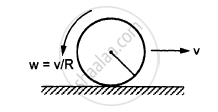Advertisements
Advertisements
प्रश्न
A man stands on a rotating platform, with his arms stretched horizontally holding a 5 kg weight in each hand. The angular speed of the platform is 30 revolutions per minute. The man then brings his arms close to his body with the distance of each weight from the axis changing from 90cm to 20cm. The moment of inertia of the man together with the platform may be taken to be constant and equal to 7.6 kg m2.
(a) What is his new angular speed? (Neglect friction.)
(b) Is kinetic energy conserved in the process? If not, from where does the change come about?
उत्तर
a) 58.88 rev/min
Moment of inertia of the man-platform system = 7.6 kg m2
Moment of inertia when the man stretches his hands to a distance of 90 cm:
2 × m r2
= 2 × 5 × (0.9)2
= 8.1 kg m2
Initial moment of inertia of the system, `I_i = 7.6 + 8.1 = 15.7 kg m^2`
Angular speed, `omega_i = 300 "rev/min"`
Angular momentum, `L_i I_iomega_i = 15.7 xx 30 ....(i)`
Moment of inertia when the man folds his hands to a distance of 20 cm:
2 × mr2
= 2 × 5 (0.2)2 = 0.4 kg m2
Final moment of inertia, `I_i = 7.6 + 0.4 = 8 kg m^2`
Final angular speed = `omega_i`
Final angular momentum, `L_i = I_iomega_i = 0.79omega_i ...(ii)`
From the conservation of angular momentum, we have:
`I_iomega_i = I_iomega_i`
`:.omega_i = (15.7 xx 30) = 58.88 rev/min`
b) No
Kinetic energy is not conserved in the given process. In fact, with the decrease in the moment of inertia, kinetic energy increases. The additional kinetic energy comes from the work done by the man to fold his hands toward himself.
APPEARS IN
संबंधित प्रश्न
If the angular momentum of a body is found to be zero about a point, is it necessary that it will also be zero about a different point?
A body is uniformly rotating about an axis fixed in an inertial frame of reference. Let \[\overrightarrow A\] be a unit vector along the axis of rotation and \[\overrightarrow B\] be the unit vector along the resultant force on a particle P of the body away from the axis. The value of \[\overrightarrow A.\overrightarrow B\] is _________.
A particle moves with a constant velocity parallel to the X-axis. Its angular momentum with respect to the origin ____________.
A particle moves on a straight line with a uniform velocity. Its angular momentum __________ .
(a) is always zero
(b) is zero about a point on the straight line
(c) is not zero about a point away from the straight line
(d) about any given point remains constant.
A wheel rotating with uniform angular acceleration covers 50 revolutions in the first five seconds after the start. Find the angular acceleration and the angular velocity at the end of five seconds.
A disc rotates about its axis with a constant angular acceleration of 4 rad/s2. Find the radial and tangential accelerations of a particle at a distance of 1 cm from the axis at the end of the first second after the disc starts rotating.
Calculate the ratio of the angular momentum of the earth about its axis due to its spinning motion to that about the sun due to its orbital motion. Radius of the earth = 6400 km and radius of the orbit of the earth about the sun = 1⋅5 × 108 km.
Suppose the platform with the kid in the previous problem is rotating in anticlockwise direction at an angular speed ω. The kid starts walking along the rim with a speed \[\nu\] relative to the platform also in the anticlockwise direction. Find the new angular speed of the platform.
Two small balls A and B, each of mass m, are joined rigidly by a light horizontal rod of length L. The rod is clamped at the centre in such a way that it can rotate freely about a vertical axis through its centre. The system is rotated with an angular speed ω about the axis. A particle P of mass m kept at rest sticks to the ball A as the ball collides with it. Find the new angular speed of the rod.
A solid sphere is set into motion on a rough horizontal surface with a linear speed ν in the forward direction and an angular speed ν/R in the anticlockwise directions as shown in the following figure. Find the linear speed of the sphere (a) when it stops rotating and (b) when slipping finally ceases and pure rolling starts.

